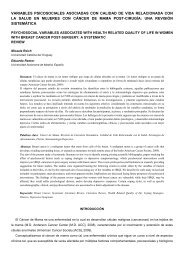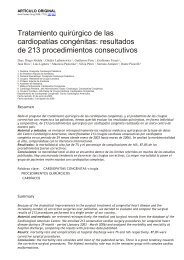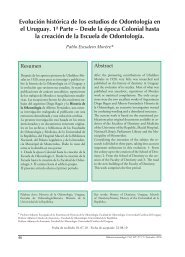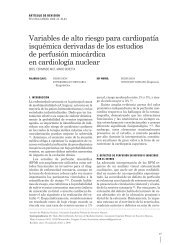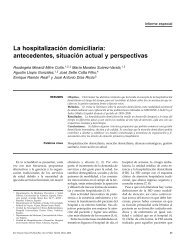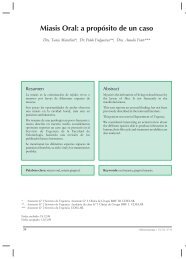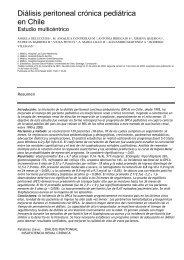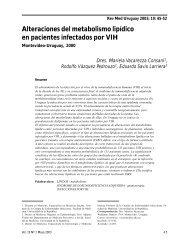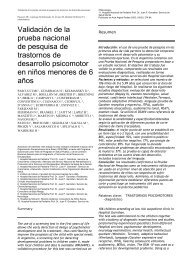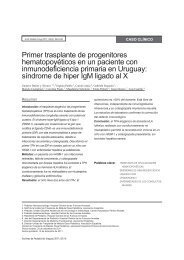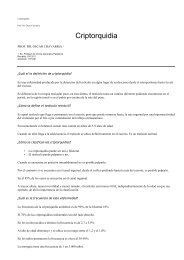paro cardiaco inesperado en anestesia raquidea - SciELO
paro cardiaco inesperado en anestesia raquidea - SciELO
paro cardiaco inesperado en anestesia raquidea - SciELO
Create successful ePaper yourself
Turn your PDF publications into a flip-book with our unique Google optimized e-Paper software.
si dejar su paci<strong>en</strong>te un plazo "prud<strong>en</strong>cial" a definir <strong>en</strong> recuperación postanestésica y/o directam<strong>en</strong>te<br />
esperar que el bloqueo retroceda completam<strong>en</strong>te antes de <strong>en</strong>viarlo a su habitación.<br />
BIBLIOGRAFIA<br />
1- Grunwald I. En el c<strong>en</strong>t<strong>en</strong>ario de la raqui<strong>anestesia</strong>. Anest Analg Reanim.1998; 14(1): 4-5.<br />
2- Caplan RA, Ward RJ, Posner K, Ch<strong>en</strong>ey FW. Unexpected cardiac arrest during spinal anesthesia.<br />
Anesthesiology 1988; 68:5-11.<br />
3- Rutstein DD, Ber<strong>en</strong>berg W, Chalmers TC. Measuring the quality of medical care: a clinical method.<br />
New Engl.J.Med 1976; 294(11): 582-8.<br />
4- Auroy Y, Narchi P, Messiah A, Litt L, Rouvier B, Samil K. Serious complications related to regional<br />
anesthesia: results of a prospective survey in France. Anesthesiology 1997; 87: 479-86<br />
5- Palmer SK. What is the incid<strong>en</strong>ce of arrest and near arrest during spinal and epidural analgesia?:<br />
Report of nine years’ experi<strong>en</strong>ce in an academic group practice. Anesth Analg 2001; 92:S339.<br />
6- Pollard JB. Cardiac arrest during spinal anesthesia: common mechanisms and strategies for prev<strong>en</strong>tion.<br />
Anesth Analg 2001; 92: 252-6.<br />
7- Pollard JB. Cardiac arrests during spinal anesthesia. APSF Newsletter 2001; 16(3): 41-2.<br />
8- Tarkkila PJ, Kaukin<strong>en</strong> S. Complications during spinal anesthesia: a prospective study. Reg Anesth<br />
1991; 16: 101–6.<br />
9- Geffin B, Shapiro L. Sinus bradycardia and asystole during spinal and epidural anesthesia: a report of<br />
13 cases. J Clin Anesth 1998; 10 :278-85<br />
10- Biboulet P, Aubas P, Dubourdieu J, Rub<strong>en</strong>ovitch J, Capdevila X, d'Athis F. Fatal and no fatal cardiac<br />
arrests related to anesthesia. Can J Anesth 2001; 48: 326-32.<br />
11- Newland MC, Ellis SJ, Lydiatt CA, Peters KR, Tinker JH, Romberger DJ et al. Anesthetic-related<br />
Cardiac Arrest and Its Mortality: A Report Covering 72,959 Anesthetics over 10 Years from a US<br />
Teaching Hospital. Anesthesiology 2002; 97: 108-15.<br />
12- Jacobs<strong>en</strong> J, Sofelt S, Brocks V, Fernandes A, Warberg J, Secher NH. Reduced left v<strong>en</strong>tricular<br />
diameters at onset of bradycardia during epidural anesthesia. Acta Anesthesiol Scand 1992; 10: 831-6.<br />
13- Cucchiara RF. Meph<strong>en</strong>teramine and intrav<strong>en</strong>ous fluids for the prev<strong>en</strong>tion of hypot<strong>en</strong>sion associated<br />
with spinal anesthesia. Anesthesiology 1973; 39: 109-10.<br />
14- Sancetta SM. Studies of hemodynamic changes in humans following induction of low and high spinal<br />
anesthesia. Circulation 1952; 6: 559-71.<br />
15- Lynn R. Observations on the circulation in high spinal anesthesia. Surgery 1952;32: 195-213.<br />
16- Ockerblad NF. The use of Ephedrine in spinal anesthesia. JAMA 1997; 88: 1135-6.



